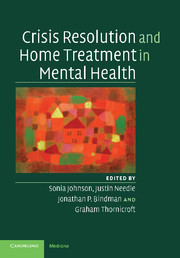Book contents
- Frontmatter
- Contents
- List of contributors
- Foreword
- Acknowledgements
- Section 1 Introduction and concepts
- Section 2 The evidence
- Section 3 Current practice
- 6 Crisis resolution teams: rationale and core model
- 7 The crisis resolution team within the community service system
- 8 Assessment of crises
- 9 Assessment and management of risk
- 10 Symptom management
- 11 Practical psychosocial interventions
- 12 Working with families and social networks
- 13 Strategies for promoting engagement and treatment adherence
- 14 Mixed blessings: service user experience of crisis teams
- 15 Early discharge and joint working between crisis teams and hospital services
- 16 Working with repeat users of crisis resolution services
- 17 Responding to diversity in home treatment
- 18 Coercion and compulsion in crisis resolution teams
- Section 4 Variations and enhancements
- Section 5 Developing a local service
- Index
- References
6 - Crisis resolution teams: rationale and core model
from Section 3 - Current practice
Published online by Cambridge University Press: 13 August 2009
- Frontmatter
- Contents
- List of contributors
- Foreword
- Acknowledgements
- Section 1 Introduction and concepts
- Section 2 The evidence
- Section 3 Current practice
- 6 Crisis resolution teams: rationale and core model
- 7 The crisis resolution team within the community service system
- 8 Assessment of crises
- 9 Assessment and management of risk
- 10 Symptom management
- 11 Practical psychosocial interventions
- 12 Working with families and social networks
- 13 Strategies for promoting engagement and treatment adherence
- 14 Mixed blessings: service user experience of crisis teams
- 15 Early discharge and joint working between crisis teams and hospital services
- 16 Working with repeat users of crisis resolution services
- 17 Responding to diversity in home treatment
- 18 Coercion and compulsion in crisis resolution teams
- Section 4 Variations and enhancements
- Section 5 Developing a local service
- Index
- References
Summary
As has been described in Chapters 2 and 3, the crisis resolution team (CRT) model has gradually evolved over the past few decades, influenced by various loosely interrelated innovations in acute community mental healthcare and promoted by a variety of interpersonal connections and international visits. Since the mid 1990s, with the nationwide implementation of CRTs in England, the model seems to have become somewhat more fixed in terms of name, organisational structure and content of interventions, but few examinations of its critical ingredients or attempts to measure degree of adherence to the model have been available. In this chapter, we aim to fill this gap by giving an account, first, of the rationale underpinning CRTs and, second, of their key organisational characteristics and components.
Information sources for this chapter
Given the previous lack of authoritative statements about the rationale and key characteristics of CRTs, this chapter seeks to strengthen the account of them by drawing on a range of expert sources. A major source is the interviews carried out by one of us (SJ) with a number of international experts on CRTs and their precursors: these interviews have already been discussed in Chapter 2 and the experts involved are listed in Box 12.1. A content analysis was carried out of these semistructured interviews.
- Type
- Chapter
- Information
- Crisis Resolution and Home Treatment in Mental Health , pp. 67 - 84Publisher: Cambridge University PressPrint publication year: 2008
References
- 8
- Cited by



